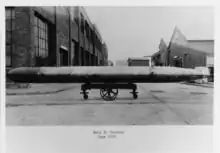| Mark 11 torpedo | |
|---|---|
 The Mark 11 torpedo at Newport, Rhode Island, torpedo factory, June 1925. | |
| Type | Anti-surface ship torpedo[1] |
| Place of origin | United States |
| Service history | |
| In service | 1926–1945 |
| Used by | United States Navy |
| Wars | World War II |
| Production history | |
| Designer | Washington Navy Yard[1] Naval Torpedo Station |
| Designed | 1926[1] |
| Manufacturer | Naval Torpedo Station[1] |
| Variants | Mod 1[2] |
| Specifications | |
| Mass | 3511 pounds[1] |
| Length | 271 inches[1] |
| Diameter | 21 inches[1] |
| Effective firing range | 6000-15,000 yards[1] |
| Warhead | Mk 11, TNT[1] |
| Warhead weight | 500 pounds[1] |
Detonation mechanism | Mk 3, Mod 1 contact exploder[1] |
| Engine | Turbine[1] |
| Maximum speed | 27-46 knots[1] |
Guidance system | Gyroscope[1] |
Launch platform | Destroyers[1] |
The Mark 11 torpedo was the first American torpedo to be designed within the United States Navy without collaboration from industry.[1] It was developed by the Washington Navy Yard in Washington, D.C., and the Naval Torpedo Station in Newport, Rhode Island. The Mark 11 torpedo was also the first to feature a three-speed setting capability while tube-loaded: high at 46 knots, medium at 34 knots and low at 27 knots. Due to stability problems it was supplemented by the Mark 12 torpedo within two years, which had a 44-knot high speed setting.
See also
References
This article is issued from Wikipedia. The text is licensed under Creative Commons - Attribution - Sharealike. Additional terms may apply for the media files.